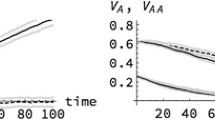Summary
Linkage, dominance, and selection interact significantly to alter the mean coefficient of inbreeding. The effect of one is not predictable without the other two. Close linkage between adjacent loci in the presence of intense selection caused a different response with overdominant gene action from with partial dominance. When selection was random, effects of linkage and dominance on the coefficient of inbreeding were nonexistent; but when selection was by either phenotype or genotype, linkage and dominance became important. Joint effects between linkage, dominance, and selection are illustrated in specific simulated populations.
Similar content being viewed by others
References
Fraser, A. S.: Simulation of genetic systems by automatic digital computer. II. Effects of linkage on rates of advance under selection. Aust. J. Biol. Sci. 10, 492–499 (1957).
Fraser, A. S.: Simulation of genetic systems by automatic digital computers. V. Linkage, dominance, and epistasis. In: O. Kempthorne (Ed.), Biometrical Genetics, pp. 70–83. New York: Pergamon Press (1960a).
Fraser, A. S.: Simulation of genetic systems by automatic digital computers. VI. Epistasis. Aust. J. Biol. Sci. 13, 150–162 (1960b).
Fraser, A. S.: Simulation of genetic systems by automatic digital computers. VII. Effects of reproductive rate and intensity of selection on genetic structure. Aust. J. Biol. Sci. 13, 344–350 (1960c).
Gill, J. L.: Effects of finite size on selection advance in simulated genetic populations. Aust. J. Biol. Sci. 18, 599–617 (1965a).
Gill, J. L.: A Monte Carlo evaluation of predicted selection response. Aust. J. Biol. Sci. 18, 999–1007 (1965b).
Gill, J. L.: Selection and linkage in simulated genetic populations. Aust. J. Biol. Sci. 18, 1171 to 1187 (1965c).
Gill, J. L., Clemmer, B. A.: Effects of selection and linkage on degree of inbreeding. Aust. J. Biol. Sci. 19, 307–317 (1966).
Greenberger, M.: Notes on a new pseudo-random number generator. J. Ass. Computing Mach. 8, 163–167 (1961).
Harris, D. L.: Genotypic covariance between inbred relatives. Genetics 50, 1319–1348 (1964).
Jain, J. K., Allard, R. W.: The effects of linkage, epistasis, and inbreeding on population changes under selection. Genetics 53, 633–659 (1966).
Kempthorne, O.: The correlation between relatives in a random mating population. Pro. Roy. Soc., London, B, 143, 103–113 (1954).
Kempthorne, O.: An Introduction to Genetic Statistics. New York: John Wiley and Sons, Inc. 1957.
Lehmer, D. H.: Mathematical methods in large scale computing units. Ann. Computer Lab., Harvard Univ. 26, 141–145 (1951).
Lewontin, R. C.: The interaction of selection and linkage. I. General considerations; heterotic models. Genetics 49, 49–67 (1964a).
Lewontin, R. C.: The interaction of selection and linkage. II. Optimum models. Genetics 50, 757–783 (1964b).
Malécot, G.: Les Mathématiques de l'Hérédité. Paris: Masson et Cie. 1948.
Marsaglia, G., Bray, T. A.: One-line random number generators and their use in combinations. Math. Note No. 551. Math. Res. Lab. Boeing Scientific Res. Labs., Seattle, Wash., 1968.
Robertson, A.: Inbreeding in artificial selection programmes. Genet. Res. 2, 189–194 (1961).
Rotenberg, A.: A new pseudorandom number generator. J. Ass. of Computing Mach. 7, 75–77 (1960).
Rowe, K. E.: Prediction of Genetic Improvement in a Finite Population under Selection. Ph. D. Thesis, Iowa State Univ., Ames, Iowa 1966.
Wright, S.: The genetical structure of populations. Ann. Eugen. 15, 323–354 (1951).
Author information
Authors and Affiliations
Additional information
Communicated by J. E. Legates
Rights and permissions
About this article
Cite this article
Miller, C.C., Gill, J.L. & McGilliard, L.D. Selection, linkage, and dominance in small populations. Theoret. Appl. Genetics 41, 130–135 (1971). https://doi.org/10.1007/BF00277754
Received:
Issue Date:
DOI: https://doi.org/10.1007/BF00277754




